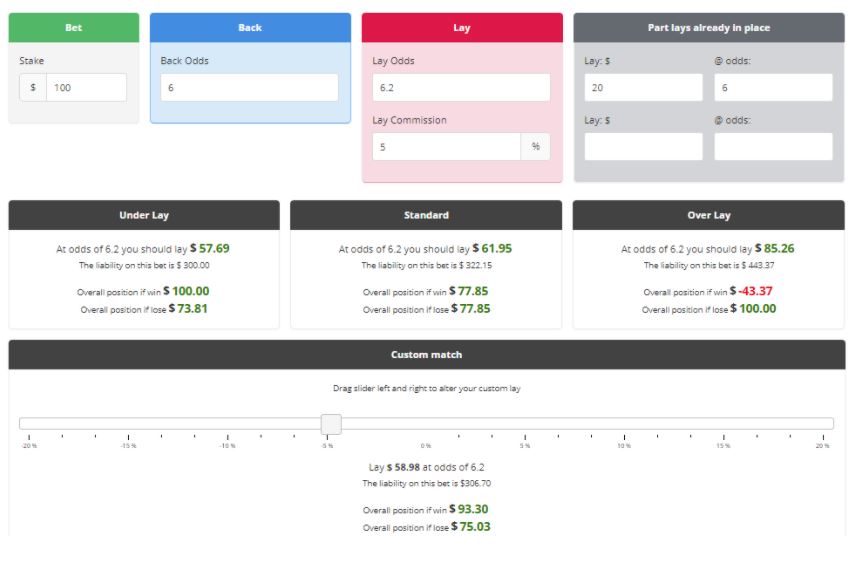EV Calculators
These calculators can be used to work out the expected value of a bookmaker promo
They might seem a little complicated at first, but they’re actually pretty straight-forward. However, they will only work for promos where we know – or can estimate – the odds of the ‘if’ part of the promo happening.
An Example Using the Back/Lay EV Calc
TAB have an NRL promo that offers ‘Double winnings, up to $50 in bonus bets, if your team win by 6 or more points’. To check the expected value of this promo, the first thing i have to do is enter the basic details of my back & lay bets into the calc.

For this example i am betting on a game between Penrith Panthers and Canberra Raiders. Because we get the bonus if the team wins, it is best to bet on the favourite.
Ideally we want to choose a stake that will give us $50 in winnings. However, to keep things simple i am using a $100 stake. This means that my max potential bonus is $40. I can enter this in the next section…

The Bonus Amount will automatically default to match your stake amount. This is fine for most bonuses but, as is the case here, sometimes you will need to overwrite it.
In the final section the only thing we have to enter is the probability of the ‘if’ happening. This can be tricky with some offers, but in this case we can find it quite easily.

We need Penrith to win by at least 6 points so we can look at the alternative handicap market to find odds on Penrith -5.5. As Betfair don’t have that market i am using another bookmaker as a guide. It is best to use a bookie with low margins. I am using TopSport, but you could also use Bet365 or Unibet.

When using a bookie’s odds to work out probability we need to account for their margin. For markets where there is only one possible winning outcome you can do that using the True Odds calculator.
However, that doesn’t work for the handicap market. Instead i am going to use the mini-calc that is below the EV calculator. This just adds 10% to the bookies odds. This is a very rough calculation but it should get us in the right ballpark.

Once i plug those new odds into the EV calc i will be able to see the expected value of the promo.

As you can see, this promo has an expected value of +$12.08 so it is definitely worth taking.
The Dutching EV Calc
If there are multiple promos available on an event, it can be better to dutch them against each other instead of laying. To calculate EV in that case you would use the Dutching EV Calculator.
This calc is almost identical. The main difference is that you enter the back odds for the opposite team instead of the lay odds.
If there are potential bonuses for both teams you will have to run the calc twice, with each team having a turn at being Team A. You can then combine the two EVs.
Advanced Probability Calculations
In the NRL example above it was pretty easy to work out the odds of the bonus triggering, but that is not always the case.
For example, Pointsbet have a promo which is an early payout if your team lead by 4+ points at half-time. In order for us to get the double payout we also need the team to lose the game.
If the promo was simply ‘Lead at HT but lose’ we could use the Half-Time/Full-Time market to work out the odds of it triggering. The ‘Lead by 4+’ part makes it more difficult though. To get around that we are going to take advantage of Same Game Multis.
On Sportsbet we can create an SGM using the ‘Alternative 1st Half Handicap’ market and the ‘Match Odds’ market.

This will give us an idea of the odds for Penrith leading by 4+ at HT and then losing the game. We still need to add the margin though.
Using this SGM approach will help you to calculate the EV of many of the less-straightforward promos. However, it doesn’t work for all of them.
For the ones that can’t be put into an SGM you can make an approximation based on the odds that are available on other markets. You could even use historical stats to estimate the probability.

